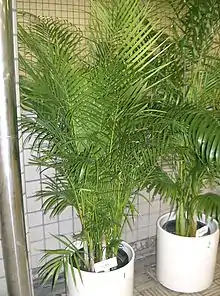Dypsis lutescens
Dypsis lutescens, also known as golden cane palm, areca palm,[3] yellow palm,[3] or butterfly palm,[3] is a species of flowering plant in the family Arecaceae, native to Madagascar and naturalized in the Andaman Islands, Réunion, El Salvador, Cuba, Puerto Rico, the Canary Islands, southern Florida, Haiti, the Dominican Republic, Jamaica, the Leeward Islands and the Leeward Antilles.[2][3]
| Dypsis lutescens | |
|---|---|
 | |
| Scientific classification | |
| Kingdom: | Plantae |
| Clade: | Tracheophytes |
| Clade: | Angiosperms |
| Clade: | Monocots |
| Clade: | Commelinids |
| Order: | Arecales |
| Family: | Arecaceae |
| Genus: | Dypsis |
| Species: | D. lutescens |
| Binomial name | |
| Dypsis lutescens | |
| Synonyms[2] | |
| |
Description
Dypsis lutescens grows 6–12 m (20–39 ft) in height. Multiple stems emerge from the base. The fronds are arched, 2–3 m (6 ft 7 in–9 ft 10 in) long, and pinnate, with 40-60 pairs of leaflets. It bears panicles of yellow flowers in summer. Offsets can be cut off when mature enough, as a propagation method.
It is grown as an ornamental plant in gardens in tropical and subtropical regions, and elsewhere indoors as a houseplant. It has gained the Royal Horticultural Society's Award of Garden Merit.[4][5]
One of several common names, "butterfly palm", refers to the leaves which curve upwards in multiple stems to create a butterfly look.[6]
.jpg.webp)
In its introduced range, this plant acts as a supplier of fruit to some bird species which feed on it opportunistically, such as Pitangus sulphuratus, Coereba flaveola and Thraupis sayaca species in Brazil.[7]
References
- Rakotoarinivo, M. & Dransfield, J. (2012). "Dypsis lutescens". IUCN Red List of Threatened Species. 2012: e.T195960A2436709. Retrieved 4 June 2020.
- "WCSP, World Checklist of Selected Plant Families: Dypsis lutescens". Archived from the original on 2007-03-11. Retrieved 2006-10-23.
- "Dypsis lutescens". Germplasm Resources Information Network (GRIN). Agricultural Research Service (ARS), United States Department of Agriculture (USDA). Retrieved 2010-12-25.
- "Dypsis lutescens". Royal Horticultural Society. Retrieved 3 June 2020.
- "AGM Plants - Ornamental" (PDF). Royal Horticultural Society. July 2017. p. 34. Retrieved 6 February 2018.
- "Real Palm Trees". Palm Tree General Description.
- Leonardo Barros Ribeiro & Melisa Gogliath Silva. "Comportamento alimentar das aves Pitangus sulphuratus, Coereba flaveola e Thraupis sayaca em palmeiras frutificadas em área urbana" (in Portuguese). Archived from the original on 2011-07-06.
External links
![]() Media related to Dypsis lutescens at Wikimedia Commons
Media related to Dypsis lutescens at Wikimedia Commons
- PACSOA: Dypsis lutescens
- Part of this article was compiled from the Portuguese Wikipedia article.
